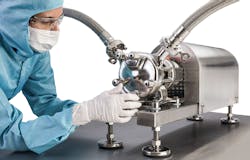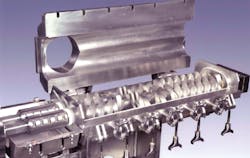The benefits of continuous processing are numerous. Switching from batch manufacturing can reduce costs and increase efficiency throughout operations. Continuous processing can also address several issues that have become more prominent during the coronavirus pandemic. Yet, pharma has yet to fully jump on the continuous bandwagon.
“Continuous processing is one approach to cut processing costs common in many industries, but — due to regulatory concerns — pharma has been a relatively slow adopter,” explains Florian Walter, product manager at Watson-Marlow Fluid Technology Group.
In addition to regulatory hurdles, manufacturers looking to transition to continuous face a number of other operational challenges. But pharma vendors are innovating solutions that can help manufacturers leverage the benefits of going continuous.
Improving safety
Before the coronavirus pandemic, David Sieglitz, president of Readco Kurimoto, says there was a lot of interest in switching from batch to continuous, mostly for improved product quality. Now, given the increased concerns with safety, that interest has grown.
“We’re experiencing more interest in boosting production rates to meet increased demand,” Sieglitz says. “At the same time, manufacturers are struggling with how to safely manage and support staff in the workplace. The ability to run 24/7 unattended has become much more valuable.”
The Readco continuous processors are available in nine standard paddle diameter sizes in custom configurations.
Readco’s line of continuous mixing processors were developed to solve the quality and consistency challenges with batch and eliminate several processing steps to create a faster cycle time while yielding a high-quality, homogeneous product. The processors feature twin shaft, co-rotating screws set within a closed barrel to promote the contact among wet and dry materials needed to ensure the end product at discharge meets desired specifications for moisture, texture, color, uniformity, and other criteria.
“Additionally, the continuous processors can be controlled and monitored remotely online from a phone or tablet anywhere in the world,” Sieglitz says. “The continuous processor limits human interaction and errors while keeping operators safe and healthy.”
Confronting contamination
“The pharmaceutical industry is facing challenges to cut costs and produce medicines more efficiently, as the pressure of aging populations on health care systems is transferred onto pharma,” Walter says.
Despite the benefits of continuous processing, Walter points out that companies have to be careful that quality is not sacrificed when transitioning from batch operations.
“Concerns lie in the ability to maintain product consistency and quality without risking contamination,” Walter says. “It’s therefore important for equipment providers to ensure sterility and product quality is maintained throughout the extended production cycles of continuous processing.”
To that end, Watson-Marlow recently launched the Certa Plus series of sinusoidal pumps that Walter says provide sustainable, high quality, versatile fluid management. According to Walter, the Certa Plus line is capable of transferring and handling a wide range of challenging products — from syrups and sugar solutions to lozenge products.
“These pumps offer lower shear to protect the quality of high value medicinal products, lower power consumption to further reduce costs, full traceability for regulatory satisfaction and clean-in-place capabilities to ensure sterility and minimize cleaning time in continuous processes,” Walter says.
Christian Ott, manager of R&D Biotech and Life Sciences at Schott, also cautions that with some biopharma processes, this risk of contamination with continuous processing can increase.
“As a direct consequence of continuous processing, the longer operating life of the cultivation compared to traditional manufacturing increases the risk of potential contamination,” Ott says. “Further, when different operation units in upstream and downstream processing are not working at the same pace, buffers in between are needed.”
To that end, Schott developed non-invasive process analytical technology (PAT) components, called ViewPort, that enable in-situ bioprocess monitoring without compromising the sterile boundary.
One key benefit of the ViewPort customizable components is that they enable the control of key process parameters — such as saccharides, peptides and cell growth — in real time, which can be measured through tightly-sealed optical windows. Ott says that not having to open the bioreactors for such measurements results in a significantly reduced risk of contamination.
“Real-time monitoring means that the processing times can be adapted to bring the operation units into an equilibrium,” Ott says.
Increasing independence
Digital technologies can also play a critical role in moving to continuous.
“Modernization of manufacturing, including continuous, can be enabled by technologies such as AI and machine learning,” says Rajiv Anand, the CEO of Quartic.ai.
Earlier this year, Quartic.ai and Bright Path Labs partnered to develop an AI-powered continuous manufacturing platform for APIs and other small molecule drugs. According to the companies, the AI tool will combine Bright Path Labs’ continuous flow Spinning Tube-in-Tube bioreactor with Quartic.ai’s smart manufacturing technology, which will speed the design, validation and approval of molecules.
The companies say that the new solution will not only improve continuous processing, it will also make API production more attractive to American manufacturers. If more API production is moved to the U.S., it will decrease our reliance on imports.
“This new AI-powered joint solution will help strengthen America’s drug manufacturing independence and ensure a critical supply of medicines to patients,” Larry Taber, chief technical officer of Bright Path Labs, says.
Top image: Watson-Marlow’s Certa Plus pumps offer lower shear, lower power consumption, full traceability and ultimate cleanability.

